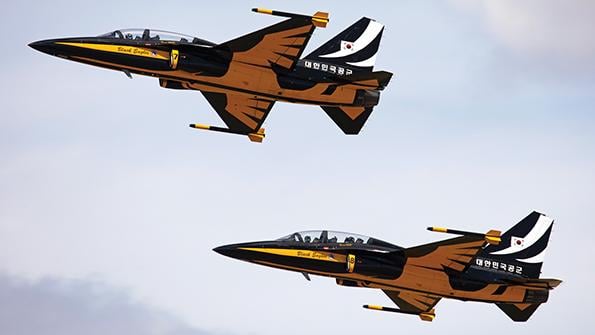
Poland has turned to South Korea to help it quickly modernize its armed forces in the face of Russia’s invasion of neighboring Ukraine.
Agreements between Warsaw and Seoul signed July 27 pave the way for the purchase of dozens of aircraft and hundreds of main battle tanks and self-propelled artillery pieces—a jackpot for South Korea’s burgeoning defense industry that could be worth 19.4 trillion won ($14.8 billion).
The deal potentially positions South Korea as Poland’s second most important defense procurement partner, behind the U.S. and ahead of the rest of Europe. A contract for 48 FA-50 light attack aircraft—a derivative of the Korea Aerospace Industries (KAI) T-50 Golden Eagle jet trainer—crucially secures KAI’s first ever European order, and the manufacturer’s largest export deal so far, worth around $3 billion.
- NATO member is buying 48 FA-50s to replace MiG-29s and Su-22s
- Poland to get service center
KAI’s breakthrough in Europe, with an increasingly important NATO member state, could position the company for further opportunities in the region. The company had previously managed to sell KT-1 Woongbi turboprop training aircraft to Turkey.
The OEM is already actively marketing the T-50 to Slovakia. There are also numerous countries in Europe with aging training fleets, which KAI believes could be a shoo-in for the General Electric F404-powered platform.
But first, the company must deliver. Poland’s urgent needs mean KAI must hand over the first 12 FA-50s by mid-2023, possibly with aircraft diverted from South Korean orders. The remaining 36 will be in a bespoke configuration called FA-50PL, a variant based on the Block 20 version of the aircraft equipped with an active, electronically scanned array radar and integrated with air-to-air and air-to-ground weapons, KAI CEO Ahn Hyun-Ho said at the July 27 contract signing ceremony in Warsaw.
Along with delivering the aircraft, KAI will cooperate with Polish industry on the creation of a service center to support FA-50s, both in-country and for future European customers.
“It is the beginning of joint cooperation, not simply sales,” Hyun-Ho said, adding that any FA-50 buyers could be “potential customers of the future KF-21 [Boramae indigenous fighter].”
“For KAI, the European market is useful, but not crucial,” says industry analyst Richard Aboulafia, managing director of AeroDynamic Advisory. “They have been doing well enough with an Asian/Middle East/emerging market strategy, but Poland really matters more from the standpoint of volume and critical mass rather than as a NATO country endorsement.”
The FA-50s will replace Poland’s aging fleet of Warsaw Pact-era Sukhoi Su-22 “Fitters” and Russian Aircraft Corp. MiG-29 “Fulcrums,” and will equip three air force squadrons. The two Soviet-era combat aircraft are seen as obsolete and increasingly difficult to support and maintain, say Polish defense officials.
The first batches of FA-50s are also expected to support flight training, potentially taking on part of the mission for which Poland purchased the Leonardo M-346, a type officials say has been experiencing availability issues.
Lt. Col. Krzysztof Platek, a Polish defense materiel agency spokesman, told Polish defense journal Defence24 that the FA-50 had been selected because of its rapid availability. He added that their capabilities, particularly once the more advanced FA-50PLs are introduced, would exceed the capabilities of the MiG-29 and Su-22 and would be “fully complementary” to Poland’s Lockheed Martin F-16s and its future F-35 Joint Strike Fighter fleet. The FA-50PL could even be armed with the Raytheon AIM-120 advanced medium-range, air-to-air missile in the future, Platek suggested.
Another likely motivation for purchasing the FA-50 was its acquisition price and operating costs, Aboulafia suggests. “One preliminary lesson of Russia’s Ukraine war is that numbers matter,” he says.
The agreements with South Korea add to a growing list of major procurements signed by Warsaw, with billions of dollars flowing out to pay for uncrewed aircraft systems, surface-to-air missile systems, a bespoke tank destroyer system and a fleet of battlefield helicopters. The Polish government has also approved increases in defense spending to 2.4% of GDP this year, with plans to raise this to 3% of GDP from 2023.
Defense Minister Mariusz Blaszczak says the deal with South Korea would “significantly strengthen” the Polish Armed Forces. “This strengthening is extremely important in view of the situation on our eastern border,” he says. “We don’t have time, we can’t wait, we have to arm the Polish Army.”





